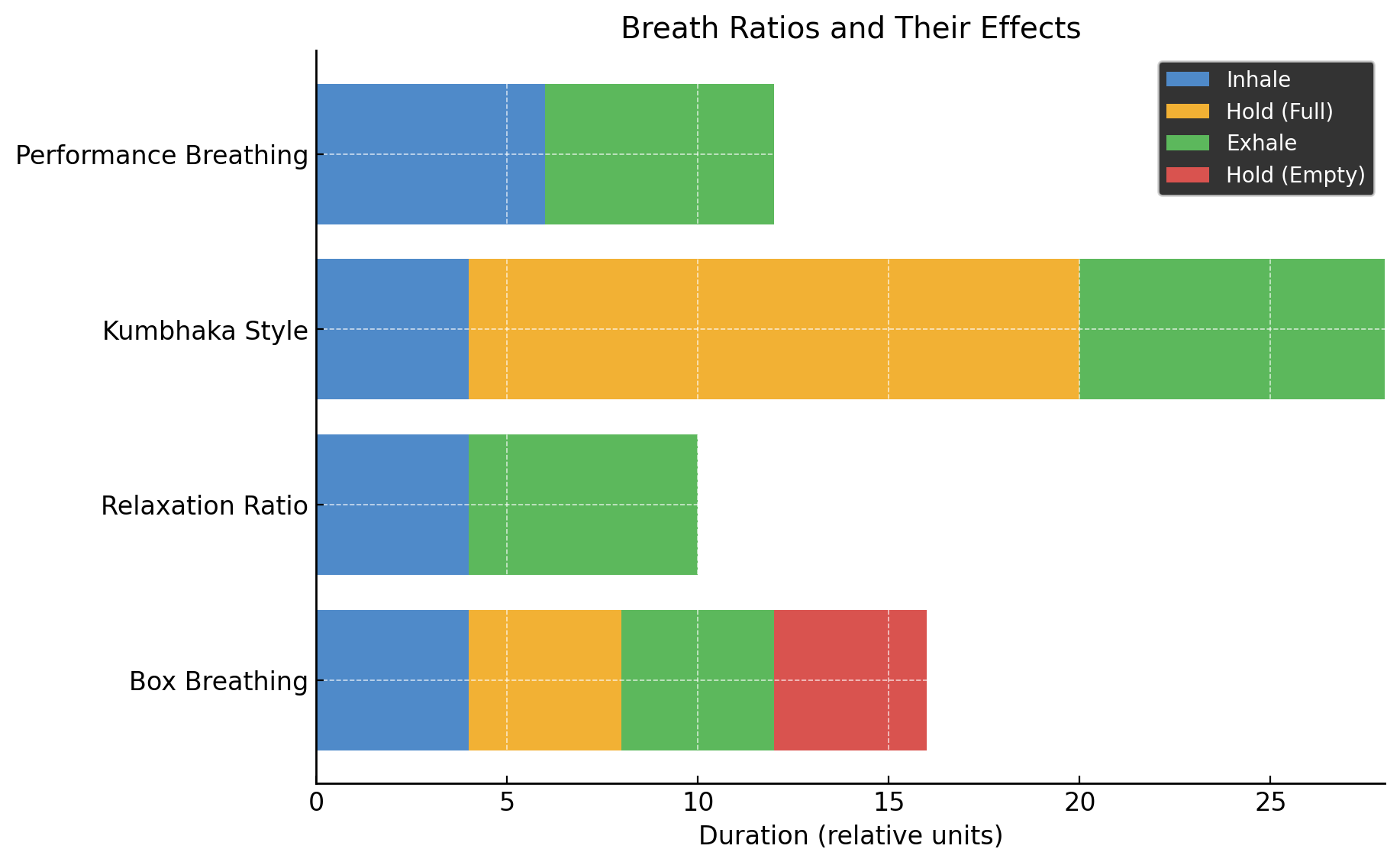Breath Ratios – The Hidden Math of Conscious Breathing #
“Prāṇa is the hub of the wheel of life, and all else depends on it.”
— Chāndogya Upaniṣad
Conscious breathing techniques often rely on specific breath ratios—combinations of inhale, hold, exhale, and hold durations—to create different physiological and psychological effects. Whether it’s box breathing (4:4:4:4), yogic pranayama (like 1:4:2), or performance-focused breathing (e.g. 6:0:6:0), these ratios aren’t arbitrary—they subtly manipulate your nervous system, gas exchange, and attention. Understanding the theory behind breath ratios gives you the tools to craft your own breathwork protocols.
Core Concept: Ratios, Not Seconds #
While many breathwork tutorials offer timings in seconds, experienced practitioners think in ratios. A 1:2 exhale-focused ratio could be 4:8, 5:10, or 6:12 seconds. The absolute time can be adjusted for comfort, but the ratio determines the effect.
Physiological Effects of Different Ratios #
- Longer exhales (1:2) activate the parasympathetic nervous system—great for calming and sleep.
- Equal ratios (1:1 or 4:4:4:4) support balance, present-moment awareness, and cognitive reset.
- Longer holds (especially after inhaling) may increase CO₂ tolerance and improve focus but can also induce stress if overdone.
A Simple Framework #
Breath ratios generally follow this structure: Inhale : Hold (full lungs) : Exhale : Hold (empty lungs)

Each color represents a phase of the breath. The length of each bar reflects its relative duration and influence on nervous system response.
Examples:
- Box Breathing – 4:4:4:4 – Equal parts for balance and clarity.
- Relaxation Ratio – 4:0:6:0 – Emphasizes long, smooth exhalation.
- Kumbhaka Style – 4:16:8:0 – A pranayama ratio that challenges breath control and focus.
Slowing Down the Breath #
Beyond ratios, one of the most powerful variables in breathwork is total breath duration. Slowing the breath — whether through extending each phase or simply decreasing breaths per minute — has profound effects on physiology, attention, and state of consciousness.
As the breath slows:
- CO₂ tolerance increases, allowing for calmer retention and improved oxygen delivery
- Heart rate variability (HRV) rises, supporting emotional regulation
- Brainwave activity shifts toward alpha and theta ranges
- Perception of time dilates; inner space becomes more vivid
One of the stangest, but most common, effects is that gentle full-body sweating may occur as the body adjusts to deep internal stillness.
Digestive activity also decreases. You will find that doing this on a full stomach is nearly impossible and often uncomfortable.
Anecdotally, practitioners describe a point during slow breath sessions where the breath seems to vanish—as if the body is breathing itself, or has become so still that only awareness remains. This threshold often precedes profound meditative absorption or spontaneous visionary imagery.
Benchmarks to Explore #
- 4–6 breaths per minute is a common target in modern therapeutic breathwork
- 1 full breath per minute (e.g. 20:20:20:0) is a traditional yogic challenge
Going Longer #
Once you can comfortably manage one breath per minute at 20:20:20:20 seconds, things start getting interesting. This is similar to how meditation only really gets good after about 20 minutes, and only after you have a regular practice. It takes a while for your nervous system to settle down, and then the real work begins. A simple process for exploring this might be:
- Sit or kneel in meditation asana
- Begin alternate nostril box breathing to a 4 count
- Close your eyes and focus attention on a tiny dot at the point of your third eye
- After about 10 minutes, switch to a relaxation ratio (4:0:6:0)
- Consciously slow down each breath
- Return awareness to the breath each time your mind wanders
- After about ten minutes of this, switch to a 1:1 inhale:exhale (no holds)
- Now start slowing the breath as much as possible
- Perservere with moderate discomfort, but don’t be an idiot
Aim for a full 60 seconds per inhale and a full 60 seconds per exhale.
The total session should be about an hour. So 20-30mins to settle into it and 30-40 of real practice.
There is a certain tension to this process. You will need to push against discomfort, but if you push too much, the increase in arousal will drive you to need more oxygen and make you breath quicker. You will need to relax and yield as much as you strain and persist. Listen to your body.
Related Topics #
- The Buteyko Method and CO₂ tolerance